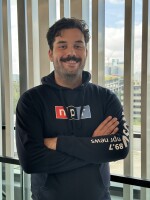Honda is starting production of a brand new hydrogen fuel cell and electric battery powered version of its popular CR-V SUV at its Marysville plant.
The four-door fuel cell electric vehicle, or FCEV, will be the only such vehicle made in North America, according to the company. Honda's Performance Manufacturing Center, or PMC, overhauled its facility to start cranking out the car.
The hydrogen fuel cells can help the car travel 270 miles on one full tank and the extra plug-in chargeable battery provides another 29 miles for shorter trips around town. Those fuel cells are also made in the U.S. in Brownstown, Michigan in a partnership with General Motors.
The company celebrated the vehicle at an event on Wednesday at the Marysville plant. The car helped the company reach its sustainability goals to have all of the new cars it sells by 2040 be zero-emission models.
Honda's Plant Project Leader Bill Peck says the vehicle can switch from hydrogen to electricity depending on how far it's traveling.
"Let's say I'm going to the grocery store. I don't have to use any hydrogen. I can put it in electric mode. I can charge it overnight and I can drive to the grocery store up to 29 miles, whatever I want. And I never have to touch the hydrogen. So I can plan my route," Peck said.
Although the car is being built in Ohio, initially it will only be released in California. Honda said that state is the only one with necessary infrastructure and ample hydrogen-fueling stations to support a person who drives the vehicle.
"We're going to lease in California because hydrogen's available in California. So where you would want to lease it, you want to be fair to the customer and it's readily available in California. So it makes sense to sell them there," Peck said.
Peck said California could be a testing ground for the technology. He said southern California and Sacramento have most of the hydrogen-fueling stations.
"It's to put it in the market and to prove it's viable," Peck said.
WOSU got to test drive the vehicle. Driving it is as silent as any other electric vehicle. There's a small hum that sounds slightly like a muffled siren. The hum of the engine becomes a little louder and sounds more like other cars when you speed up or switch into sport mode.
The car lets drivers switch between several modes including sport mode, snow mode, electric mode and a normal mode.
Peck described how the fuel cells convert the gaseous hydrogen fuel into electricity the car needs to run.
"How it works is hydrogen is compressed to 70 mega pascals introduced into the tank. The two tanks that you've seen during the tour into the back (and) it's distributed into the fuel cell where cold combustion happens and we transfer direct gas into electricity. Some of it's used in the powertrain to drive the vehicle. Some of it's stored in the battery for later use," Peck said.
Peck and his colleagues mentioned throughout the day how proud they were of their work and their team. The PMC facility was completely overhauled to make room to build the vehicle, including tearing up the floor. The building had previously produced the Acura NSX supercar.
Honda has not said what price the new CR-V will go for.
Hydrogen is also a costly fuel to use in California where most of the fueling stations are located. Bloomberg reports it costs the equivalent of $15 a gallon of gasoline to fill up a hydrogen fuel cell on similar cars already on the market — or about $200 per fill up.
With the electric battery and its charging capabilities, drivers may not have to fill up on hydrogen fuel as often.
Peck said Honda eventually wants to see hydrogen fuel expanded to other states across the country.
"We're interested, we're trying. We want to move it out. We want more. We want to be able to say, okay, now Ohio is on the map. We want that. But it's not ready yet," Peck said.

















